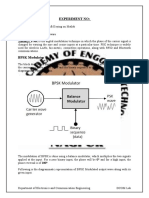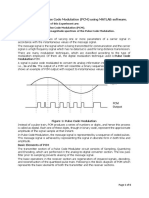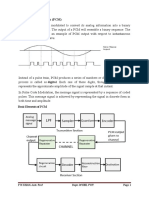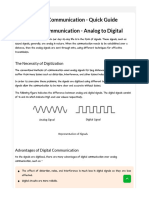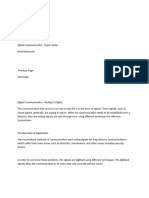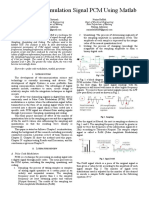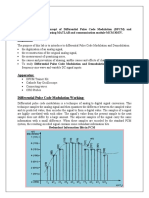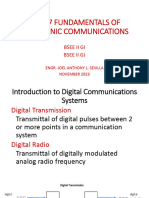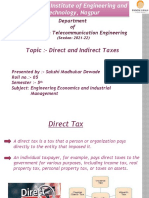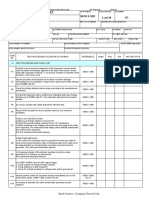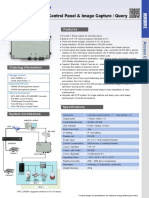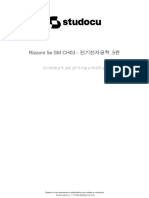PCM Lab Manual
Uploaded by
Sakshi DewadePCM Lab Manual
Uploaded by
Sakshi DewadeEXPERIMENT NO:
Aim: To Study Pulse Code Modulation on Matlab
Apparatus: Matlab Software
Theory: Modulation is the process of varying one or more parameters of a carrier signal in
accordance with the instantaneous values of the message signal.
The message signal is the signal which is being transmitted for communication and the carrier
signal is a high frequency signal which has no data, but is used for long distance
transmission.
There are many modulation techniques, which are classified according to the type of
modulation employed. Of them all, the digital modulation technique used is Pulse Code
Modulation PCM
A signal is pulse code modulated to convert its analog information into a binary sequence,
i.e., 1s and 0s. The output of a PCM will resemble a binary sequence. The following figure
shows an example of PCM output with respect to instantaneous values of a given sine wave.
Instead of a pulse train, PCM produces a series of numbers or digits, and hence this process is
called as digital. Each one of these digits, though in binary code, represent the approximate
amplitude of the signal sample at that instant.
In Pulse Code Modulation, the message signal is represented by a sequence of coded pulses.
This message signal is achieved by representing the signal in discrete form in both time and
amplitude.
Department of Electronics and Communication Engineering DCOM Lab
Basic Elements of PCM
The transmitter section of a Pulse Code Modulator circuit consists of Sampling, Quantizing
and Encoding, which are performed in the analog-to-digital converter section. The low pass
filter prior to sampling prevents aliasing of the message signal.
The basic operations in the receiver section are regeneration of impaired signals, decoding,
and reconstruction of the quantized pulse train. Following is the block diagram of PCM
which represents the basic elements of both the transmitter and the receiver sections.
Low Pass Filter
This filter eliminates the high frequency components present in the input analog signal which
is greater than the highest frequency of the message signal, to avoid aliasing of the message
signal.
Sampler
This is the technique which helps to collect the sample data at instantaneous values of
message signal, so as to reconstruct the original signal. The sampling rate must be greater
than twice the highest frequency component W of the message signal, in accordance with the
sampling theorem.
Department of Electronics and Communication Engineering DCOM Lab
Quantizer
Quantizing is a process of reducing the excessive bits and confining the data. The sampled
output when given to Quantizer, reduces the redundant bits and compresses the value.
Encoder
The digitization of analog signal is done by the encoder. It designates each quantized level by
a binary code. The sampling done here is the sample-and-hold process. These three sections
LPF,Sampler,andQuantizer
will act as an analog to digital converter. Encoding minimizes the bandwidth used.
Regenerative Repeater
This section increases the signal strength. The output of the channel also has one regenerative
repeater circuit, to compensate the signal loss and reconstruct the signal, and also to increase
its strength.
Decoder
The decoder circuit decodes the pulse coded waveform to reproduce the original signal. This
circuit acts as the demodulator.
Reconstruction Filter
After the digital-to-analog conversion is done by the regenerative circuit and the decoder, a
low-pass filter is employed, called as the reconstruction filter to get back the original signal.
Hence, the Pulse Code Modulator circuit digitizes the given analog signal, codes it and
samples it, and then transmits it in an analog form. This whole process is repeated in a
reverse pattern to obtain the original signal.
Procedure: 1. Open Matlab Software
2. Click on New Script and Start to write a Program
3. After wrote Save and Run Program
4. Command Window will open
5. Give the Following Input to generate FSK modulated wave.
6. Enter Bit Depth Of PCM Coding:2
Department of Electronics and Communication Engineering DCOM Lab
Circuit Diagram/Block Diagram/Flow chart/Program:
clc
close all
clear all
t = 0:0.0001:20; %sampling at niquist rate
c=input('Enter Bit Depth Of PCM Coding:');
part = -1:0.1:1;%A quantization partition defines several contiguous,
nonoverlapping ranges
%of values within the set of real numbers.
codebook = -1:0.1:1.1;%A codebook tells the quantizer which common value to
assign to inputs that
%fall into each range of the partition.
msg = cos(t);
[~,quants] = quantiz(msg,part,codebook);%returns a vector that tells which
interval each input is in
subplot(3,1,1);
plot(t,msg);
title('Message Signal');
subplot(3,1,2);
plot(t,quants);
title('Quantized Signal');
y = uencode(quants,c);
ybin=dec2bin(y,c); %converting it to final binary form to make it transmit
ready
subplot(3,1,3);
plot(t,y);
title('PCM PLOT');
Department of Electronics and Communication Engineering DCOM Lab
Results:
Conclusion: Hence we studied Pulse Code Modulation successfully on Matlab
Software
Viva questions:
1. What are the advantages of PCM?
2. What is Quantization Noise?
3. What are the application of PCM?
Department of Electronics and Communication Engineering DCOM Lab
You might also like
- Pfister MSR 1 DBW COMMISSIONIG MANUAL - GB - (KPL)100% (2)Pfister MSR 1 DBW COMMISSIONIG MANUAL - GB - (KPL)127 pages
- Pulse Code Modulation: Modulation Is The Process of Varying One or More Parameters of A Carrier Signal inNo ratings yetPulse Code Modulation: Modulation Is The Process of Varying One or More Parameters of A Carrier Signal in3 pages
- Experiment 7 Pulse Code Modulation (PCM) : 1.0 ObjectivesNo ratings yetExperiment 7 Pulse Code Modulation (PCM) : 1.0 Objectives5 pages
- Pulse Code Modulation (PCM) .: Basic Elements of PCMNo ratings yetPulse Code Modulation (PCM) .: Basic Elements of PCM2 pages
- Task No. 2: Generation of Signal Using PCMNo ratings yetTask No. 2: Generation of Signal Using PCM7 pages
- Activity No. 3 Pulse Code Modulation: Perez, Patricia Grace P. Student Number: 201912327 Bscpe 3-1 Cpen 80No ratings yetActivity No. 3 Pulse Code Modulation: Perez, Patricia Grace P. Student Number: 201912327 Bscpe 3-1 Cpen 805 pages
- Performance of Waveform Coding PCM - MatlabNo ratings yetPerformance of Waveform Coding PCM - Matlab7 pages
- Pulse Code Modulation: Zakaria Sembiring, ST.,MSC Computer Engineering Politeknik Negeri MedanNo ratings yetPulse Code Modulation: Zakaria Sembiring, ST.,MSC Computer Engineering Politeknik Negeri Medan16 pages
- Analog and Digital Communication - Quick GuideNo ratings yetAnalog and Digital Communication - Quick Guide70 pages
- Task No. 2: Generation of Signal Using PCMNo ratings yetTask No. 2: Generation of Signal Using PCM7 pages
- Code Modulation - Pulse: Report Submitted As A Part of The Final Exam Requirement ForNo ratings yetCode Modulation - Pulse: Report Submitted As A Part of The Final Exam Requirement For8 pages
- Analysis and Simulation Signal PCM Using MatlabNo ratings yetAnalysis and Simulation Signal PCM Using Matlab5 pages
- Digital Communication Systems: Chirag Gaur 18BEC0021 L39+40 Submitted To Prof.-VELMURUGAN TNo ratings yetDigital Communication Systems: Chirag Gaur 18BEC0021 L39+40 Submitted To Prof.-VELMURUGAN T5 pages
- Principles of Communication: Digital Pulse ModulationNo ratings yetPrinciples of Communication: Digital Pulse Modulation63 pages
- Analog To Digital Conversion Digital To Analog Conversion: Tanauan City CollegeNo ratings yetAnalog To Digital Conversion Digital To Analog Conversion: Tanauan City College44 pages
- Pulse Code Modulation:: Basic Elements of PCMNo ratings yetPulse Code Modulation:: Basic Elements of PCM6 pages
- Department of Electrical and Electronics EngineeringNo ratings yetDepartment of Electrical and Electronics Engineering14 pages
- Simulation & Comparison of Various Source Coding Techniques - FINAL - PPTNo ratings yetSimulation & Comparison of Various Source Coding Techniques - FINAL - PPT22 pages
- Pulse Modulation Consists Essentially of Sampling Analog Information Signals and Then ConvertingNo ratings yetPulse Modulation Consists Essentially of Sampling Analog Information Signals and Then Converting40 pages
- 6.4 Digital Transmission: Pulse Amplitude Modulation (PAM) and Pulse Code Modulation (PCM)No ratings yet6.4 Digital Transmission: Pulse Amplitude Modulation (PAM) and Pulse Code Modulation (PCM)13 pages
- Department of Electronics AND Telecommunication Department of Electronics AND TelecommunicationNo ratings yetDepartment of Electronics AND Telecommunication Department of Electronics AND Telecommunication8 pages
- Topic:-Direct and Indirect Taxes: Department of Electronics & Telecommunication EngineeringNo ratings yetTopic:-Direct and Indirect Taxes: Department of Electronics & Telecommunication Engineering15 pages
- 4.4V_PACK SPEC_AEC363535_A011045040A_V02-20230425No ratings yet4.4V_PACK SPEC_AEC363535_A011045040A_V02-2023042513 pages
- Saudi Aramco Test Report: DC Cable Holiday Testing 3-Jul-18 CP-SATR-X-3201No ratings yetSaudi Aramco Test Report: DC Cable Holiday Testing 3-Jul-18 CP-SATR-X-32013 pages
- RAC-2400NV: TCP / IP Multi Door Control Panel & Image Capture / QueryNo ratings yetRAC-2400NV: TCP / IP Multi Door Control Panel & Image Capture / Query1 page
- Assignment 2 Series Parallel and Star Delta 1No ratings yetAssignment 2 Series Parallel and Star Delta 15 pages
- Electrical Technology Grade 11 Term 4 Week 1No ratings yetElectrical Technology Grade 11 Term 4 Week 14 pages
- Fundamentals of Electronics by Robert Boylestad 4th EditionNo ratings yetFundamentals of Electronics by Robert Boylestad 4th Edition3 pages
- Viewsonic: Vx2262Wm/Vx2262Wmp LCD DisplayNo ratings yetViewsonic: Vx2262Wm/Vx2262Wmp LCD Display25 pages
- The Comprehensive Solution For Capacitor Bank ProtectionNo ratings yetThe Comprehensive Solution For Capacitor Bank Protection8 pages
- Y3 - Module 4 - Maintaining and Repairing A BlenderNo ratings yetY3 - Module 4 - Maintaining and Repairing A Blender48 pages
- Eaton DX-RT 6000 VA (Long Back UP) 1x1 UPS System0% (1)Eaton DX-RT 6000 VA (Long Back UP) 1x1 UPS System4 pages
- Pfister MSR 1 DBW COMMISSIONIG MANUAL - GB - (KPL)Pfister MSR 1 DBW COMMISSIONIG MANUAL - GB - (KPL)
- Pulse Code Modulation: Modulation Is The Process of Varying One or More Parameters of A Carrier Signal inPulse Code Modulation: Modulation Is The Process of Varying One or More Parameters of A Carrier Signal in
- Experiment 7 Pulse Code Modulation (PCM) : 1.0 ObjectivesExperiment 7 Pulse Code Modulation (PCM) : 1.0 Objectives
- Pulse Code Modulation (PCM) .: Basic Elements of PCMPulse Code Modulation (PCM) .: Basic Elements of PCM
- Activity No. 3 Pulse Code Modulation: Perez, Patricia Grace P. Student Number: 201912327 Bscpe 3-1 Cpen 80Activity No. 3 Pulse Code Modulation: Perez, Patricia Grace P. Student Number: 201912327 Bscpe 3-1 Cpen 80
- Pulse Code Modulation: Zakaria Sembiring, ST.,MSC Computer Engineering Politeknik Negeri MedanPulse Code Modulation: Zakaria Sembiring, ST.,MSC Computer Engineering Politeknik Negeri Medan
- Code Modulation - Pulse: Report Submitted As A Part of The Final Exam Requirement ForCode Modulation - Pulse: Report Submitted As A Part of The Final Exam Requirement For
- Digital Communication Systems: Chirag Gaur 18BEC0021 L39+40 Submitted To Prof.-VELMURUGAN TDigital Communication Systems: Chirag Gaur 18BEC0021 L39+40 Submitted To Prof.-VELMURUGAN T
- Principles of Communication: Digital Pulse ModulationPrinciples of Communication: Digital Pulse Modulation
- Analog To Digital Conversion Digital To Analog Conversion: Tanauan City CollegeAnalog To Digital Conversion Digital To Analog Conversion: Tanauan City College
- Department of Electrical and Electronics EngineeringDepartment of Electrical and Electronics Engineering
- Simulation & Comparison of Various Source Coding Techniques - FINAL - PPTSimulation & Comparison of Various Source Coding Techniques - FINAL - PPT
- Pulse Modulation Consists Essentially of Sampling Analog Information Signals and Then ConvertingPulse Modulation Consists Essentially of Sampling Analog Information Signals and Then Converting
- 6.4 Digital Transmission: Pulse Amplitude Modulation (PAM) and Pulse Code Modulation (PCM)6.4 Digital Transmission: Pulse Amplitude Modulation (PAM) and Pulse Code Modulation (PCM)
- Analog Dialogue, Volume 45, Number 4: Analog Dialogue, #4From EverandAnalog Dialogue, Volume 45, Number 4: Analog Dialogue, #4
- Department of Electronics AND Telecommunication Department of Electronics AND TelecommunicationDepartment of Electronics AND Telecommunication Department of Electronics AND Telecommunication
- Topic:-Direct and Indirect Taxes: Department of Electronics & Telecommunication EngineeringTopic:-Direct and Indirect Taxes: Department of Electronics & Telecommunication Engineering
- Saudi Aramco Test Report: DC Cable Holiday Testing 3-Jul-18 CP-SATR-X-3201Saudi Aramco Test Report: DC Cable Holiday Testing 3-Jul-18 CP-SATR-X-3201
- RAC-2400NV: TCP / IP Multi Door Control Panel & Image Capture / QueryRAC-2400NV: TCP / IP Multi Door Control Panel & Image Capture / Query
- Fundamentals of Electronics by Robert Boylestad 4th EditionFundamentals of Electronics by Robert Boylestad 4th Edition
- The Comprehensive Solution For Capacitor Bank ProtectionThe Comprehensive Solution For Capacitor Bank Protection
- Y3 - Module 4 - Maintaining and Repairing A BlenderY3 - Module 4 - Maintaining and Repairing A Blender




